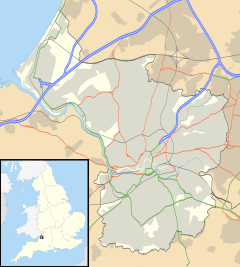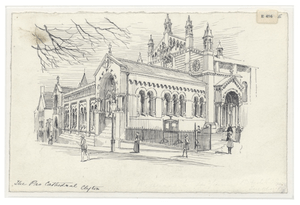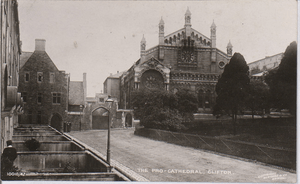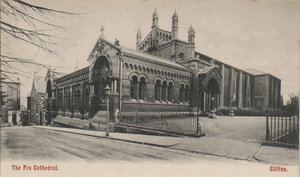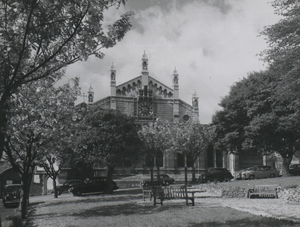Pro-Cathedral of the Holy Apostles facts for kids
Quick facts for kids Pro-Cathedral of the Holy Apostles |
|
|---|---|
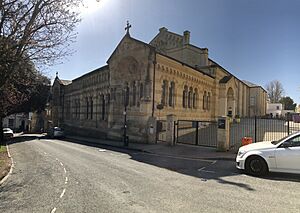
Pro Cathedral of the Holy Apostles, front
|
|
| Religion | |
| Affiliation | Roman Catholic |
| Ecclesiastical or organizational status | Cathedral |
| Year consecrated | 1850 |
| Location | |
| Location | Bristol, England |
| Architecture | |
| Architect(s) | Henry Goodridge; Charles Francis Hansom |
| Architectural type | Ecclesiastical |
| Architectural style | Palladian |
| Completed | 1850 |
The Pro-Cathedral of the Holy Apostles was an important Roman Catholic church in Bristol, England. It served as the main church, or cathedral, for the Catholic community in Bristol from 1850 until 1973. In 1973, a new church called Clifton Cathedral took its place. Today, the old Pro-Cathedral is a special building protected by law, known as a Grade II Listed Building.
Contents
Early Catholic Life in Bristol
For a long time, Roman Catholic people in England faced unfair treatment. Before a law was passed in 1791, Catholics were not allowed to hold important jobs in the government. Being a Catholic priest could even lead to being sent to prison for life. People often had strong negative feelings towards Catholics. For example, in 1780, a large protest against Catholics, known as the Gordon Riots, led to about 1,000 deaths.
History of the Pro-Cathedral
After new laws were passed in the early 1800s, Catholics in Bristol could worship more freely. Before this, they often met in private homes or even above a pub. They secretly bought a piece of land on Honeypen Hill, which is now called Park Place in Clifton.
Building the Church
Work on the church began in 1834 under Bishop Augustine Baines. The design was by Henry Goodridge, an architect from Bath. He planned a grand church in the Palladian style, which was popular during the Georgian era. This style often uses features from ancient Roman and Greek buildings.
The church was meant to have a large main hall, called a nave, with tall columns around it. The main entrance was planned to have a grand porch with more columns. A round tower with a glass roof was designed to let light into the church.
Building Challenges
Building the church was very difficult because the land was on a steep hillside. The heavy weight of the rising walls caused the foundations to keep sinking. This was a similar problem to what Isambard Kingdom Brunel faced when building the Clifton Suspension Bridge nearby.
The church project also ran into money problems. The priest in charge, Father Edgeworth, became bankrupt and left for Belgium. Bishop Baines could not help much because he was busy fixing another building that had caught fire. The unfinished church was left empty until 1848.
Finishing the Roof
In 1846, Bishop William Bernard Ullathorne was put in charge of the Catholic Church in Western England. He wanted to build a new main church in Bristol. After looking everywhere, he decided to try and fix the ruined church started by Father Edgeworth.
The building was just a shell, with no side windows and only half-built columns. Architects thought it would be impossible to put a roof on it because the walls were too thin for such a wide space.
Bishop Ullathorne asked Charles Francis Hansom, a Catholic architect who lived nearby, for help. Bishop Ullathorne told Hansom to follow his ideas. He suggested raising the walls a little higher and then adding two rows of wooden columns inside. These wooden columns would sit on strong wooden beams, like the bottom of a ship, that ran the length of the church. Above these columns, wooden arches would support a new, lighter roof. This clever plan allowed them to finish the church at a low cost.
The church opened on September 21, 1848. In 1850, Bristol became a special Catholic area called an episcopal see, and this church became the Pro-Cathedral. This meant it was the main church until a grander one could be built. Bishop Joseph William Hendren became the first Bishop of Clifton.
Inside the Pro-Cathedral, there were twelve large statues of the Apostles. These statues stood on pedestals that covered the original stone columns that had caused problems. There were also statues of the Virgin Mary and other saints like St John the Baptist and St Anthony of Padua. Near the back door, there was a statue of Saint Peter. People often touched his extended foot as they entered and left, making it smooth over time.
In the 1870s, Bishop William Clifford began to change the front of the church. Charles Hansom, the architect, redesigned the entrance, adding a schoolroom and a new facade in a North Italian Romanesque style. A tall tower with an octagonal top and a short spire was planned, but it was never fully completed.
Later Years
During the Second World War, part of the church's basement was made into an air raid shelter with strong walls. The roof had some damage from bomb fragments, but the main structure of the church was safe during the Bristol Blitz.
A New Cathedral is Built
From the 1930s to the 1950s, the church members raised a lot of money to fix and decorate the Pro-Cathedral. However, in 1964, engineers reported that the ground under the church was not stable. This created a big problem for Bishop Joseph Rudderham: should they fix the old building or build a new one somewhere else?
In 1965, architects were hired to design a new cathedral in a different part of Clifton. In 1967, cracks appeared in the Pro-Cathedral's walls because a large car park was being built below it. There were serious worries that the church's foundations might collapse. Expensive repairs were done, which helped stabilize the building for a while.
By late 1967, the decision was made to buy a new site and build a new church. A group of anonymous business people donated a large sum of money, but only if a new building was constructed. They wanted to create a new place of worship.
Construction on the new Clifton Cathedral began in March 1970. It was officially opened on June 29, 1973. The Pro-Cathedral then closed its doors.
Very few items were moved from the old Pro-Cathedral to the new one, mostly because of differences in style.
- Two bronze Bells, made in 1901.
- A very old ivory carving of Jesus on the cross. Sadly, this carving was dropped and broken in the 1990s. Even though it was repaired, it is now kept safely on a wall in a chapel.
What Happened to the Old Site?
The church sold the Pro-Cathedral site to a German charity that ran a Steiner school. The money from the sale was used to build a new primary school for the church. The Steiner school used the cathedral building until 2002, when it was sold again for new development.
In 2007, the building was used as a theatre and art space. After that, it fell into disrepair.
A New Future
In May 2011, a company bought the site to turn the Pro-Cathedral and a nearby school building into student flats. The buildings were then sold to another student housing company, and later to Unite Students. Today, the site provides housing for 263 students.
See also
 In Spanish: Procatedral de los Santos Apóstoles (Bristol) para niños
In Spanish: Procatedral de los Santos Apóstoles (Bristol) para niños


